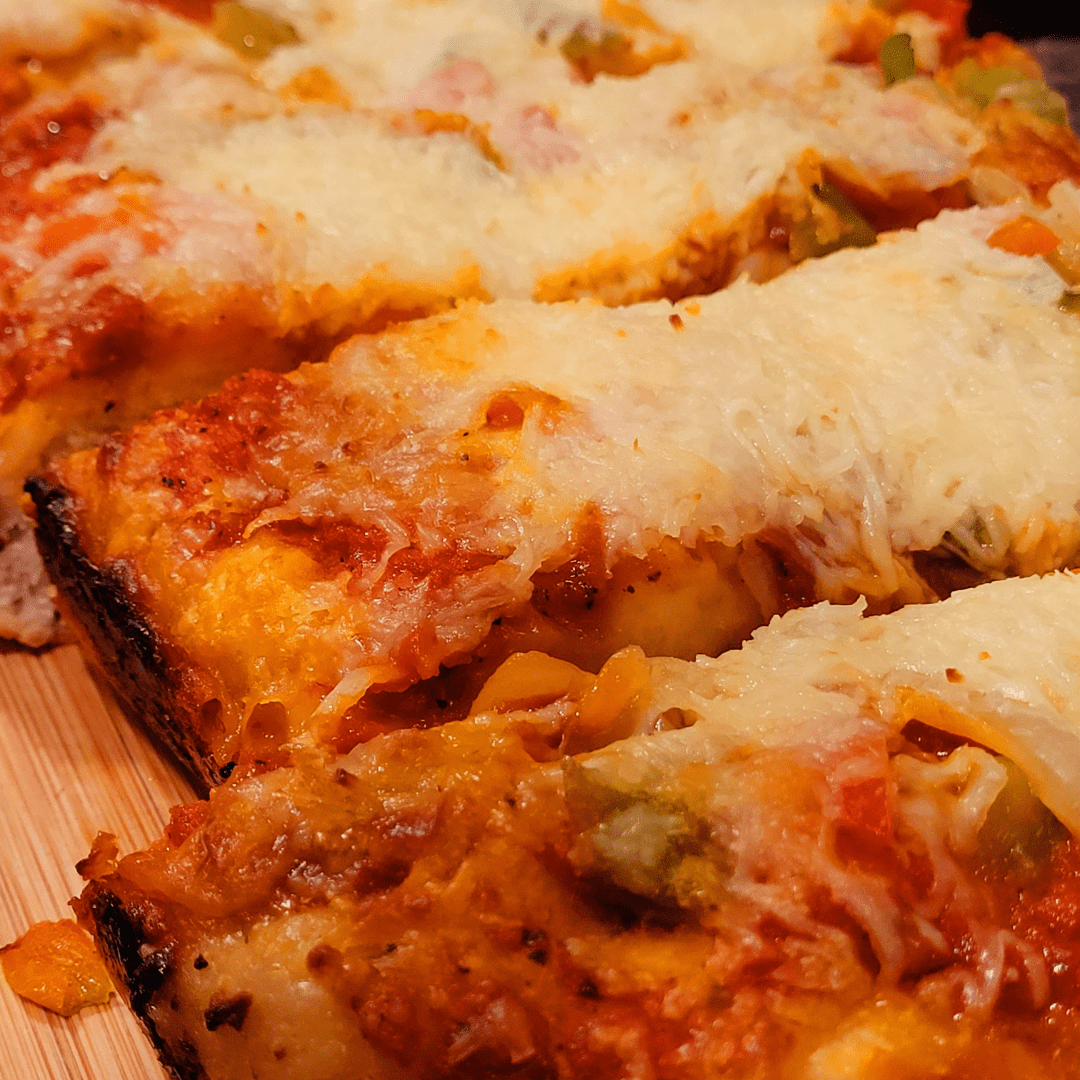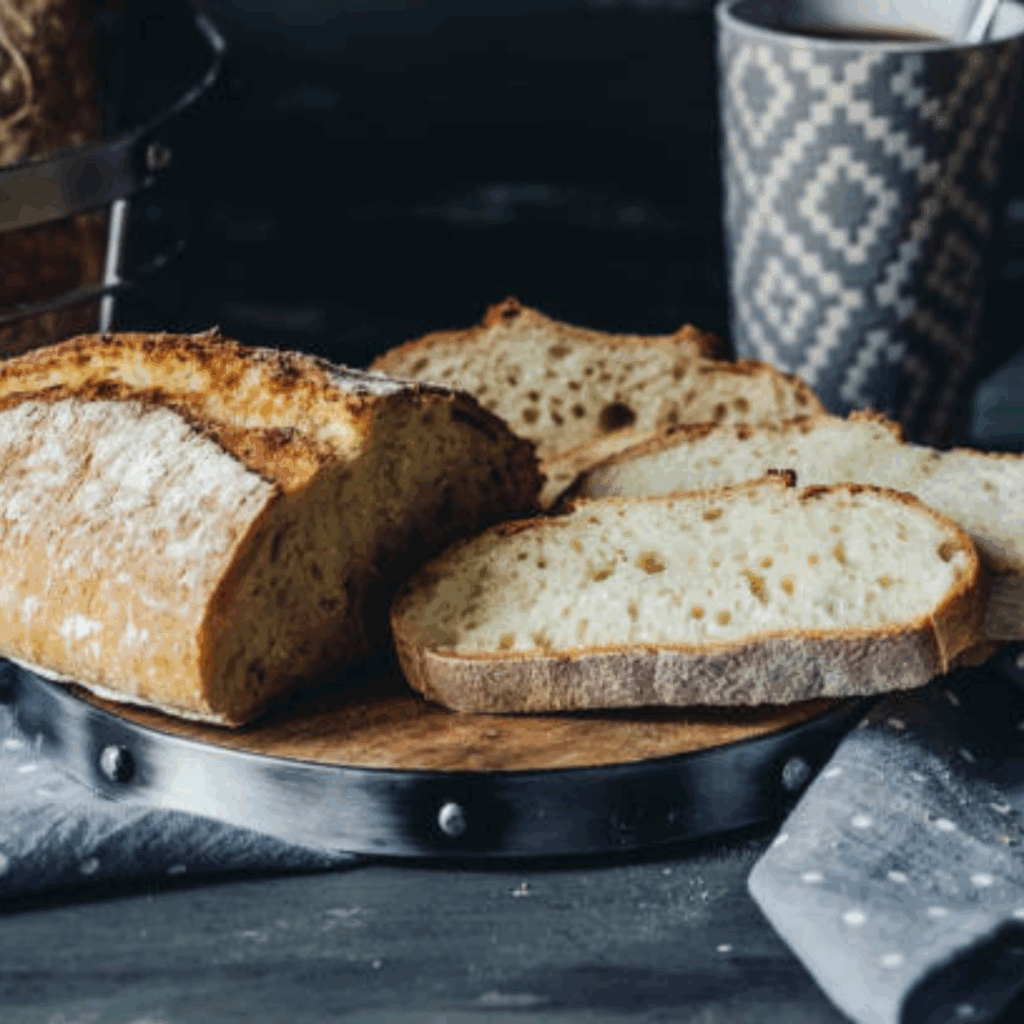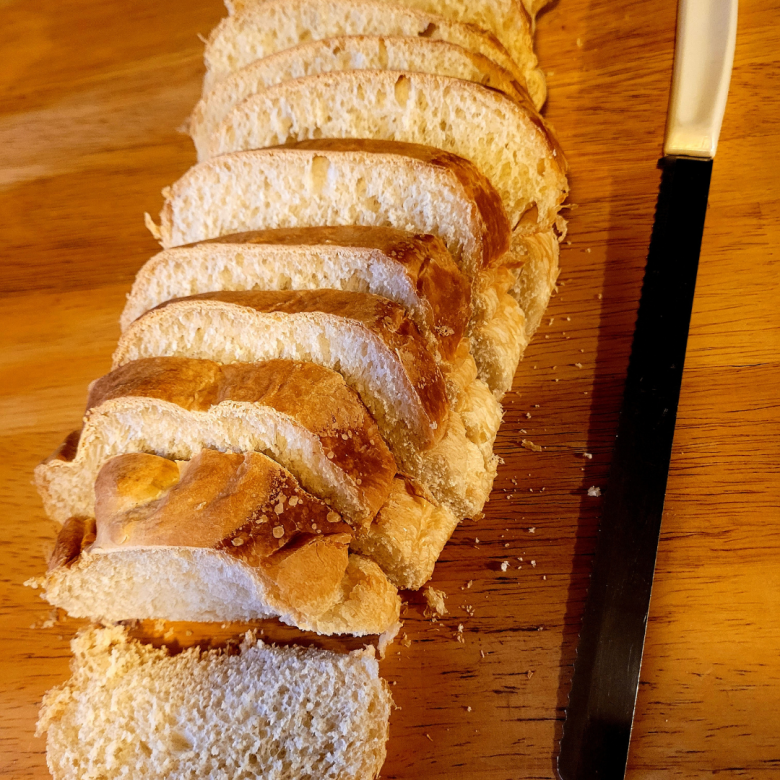Pizza Sourdough Focaccia combines the best of both worlds—chewy, airy sourdough focaccia with the bold flavors of classic pizza. This naturally fermented bread develops a rich depth of flavor while staying light and crisp.
Topped with savory ingredients like tomato sauce, cheese, and herbs, it’s the perfect fusion of pizza and artisan bread. Whether you’re making it for a casual dinner or a shareable appetizer, this recipe is an easy and delicious way to elevate your sourdough baking!
Pizza Sourdough Foccacia Recipe Tutorial
What Is Pizza Sourdough Focaccia and Why Should I Try It?
Pizza Sourdough Focaccia is the ultimate combination of two beloved classics—chewy, airy focaccia and the bold, comforting flavors of pizza. By using a naturally fermented sourdough base, this recipe creates a rich depth of flavor that you won’t get from store-bought dough.
Topped with tomato sauce, gooey cheese, and your favorite pizza toppings, it delivers everything you love about pizza but with the soft, pillowy texture of fresh-baked focaccia. Whether you’re a sourdough enthusiast or just love homemade pizza, this recipe is a must-try!
What Makes This Pizza Sourdough Focaccia So Crispy and Airy?
The magic of this focaccia is in its texture—crispy on the outside, soft and airy on the inside. Thanks to a slow-fermented sourdough base, the dough develops deep flavor while becoming beautifully light and bubbly.
The generous use of olive oil creates a golden, crunchy crust, while the natural fermentation process gives it a slight tang that pairs perfectly with savory pizza toppings. Every bite is a balance of crisp edges, chewy middle, and melty cheese, making it an irresistible take on classic pizza.
When Can I Serve Pizza Sourdough Focaccia?
One of the best things about this recipe is its versatility! It’s perfect for a weeknight dinner, served alongside a fresh salad. Cut it into squares, and it becomes a fun appetizer for parties or game nights. Need a quick snack? Heat up a slice for an easy, satisfying bite.
You can even get creative with toppings to match different occasions—classic pepperoni for a pizza night, roasted veggies for a healthier twist, or fresh basil and burrata for a gourmet touch. No matter how you serve it, this focaccia-style pizza is always a crowd-pleaser!
This is a pinnable post. Tap or hover over any image in this post to pin to your Pinterest Boards.
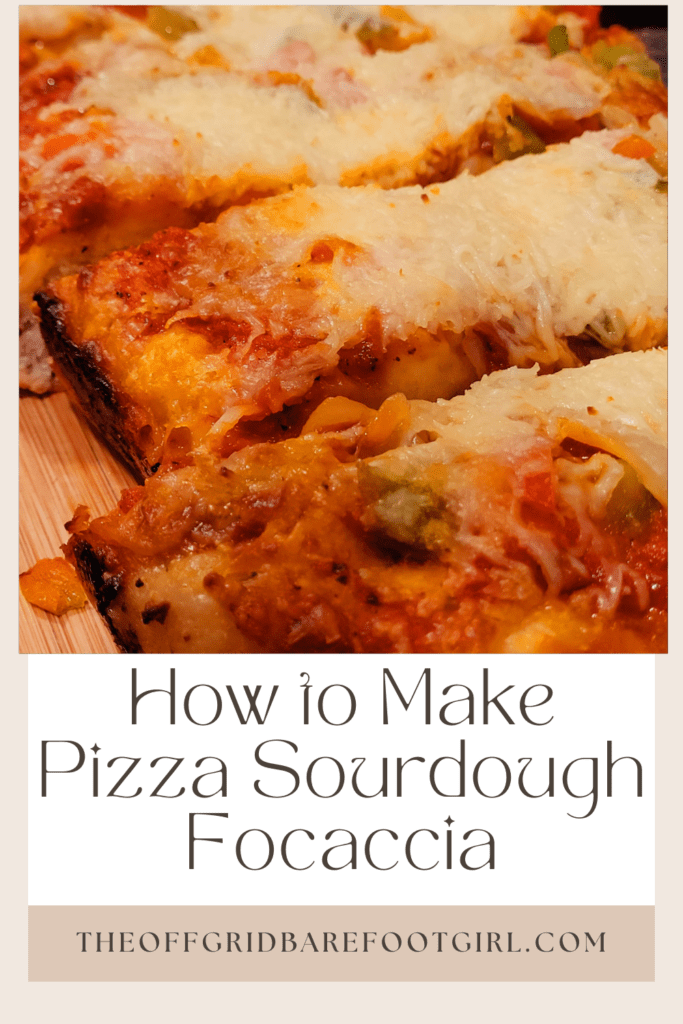
Why You’ll Love This Recipe

Why Should I Use Sourdough for My Focaccia?
Sourdough brings a unique depth of flavor to this pizza focaccia that you simply can’t achieve with regular dough. The natural fermentation process that sourdough goes through not only enhances the dough’s complexity but also makes it easier to digest.
The tangy, slightly sour taste balances out the richness of the pizza toppings, creating a perfect harmony between the bread and the toppings. Plus, sourdough’s long fermentation time allows the dough to develop a lighter, airier texture, making each bite a delight to savor. It’s the secret ingredient that takes this focaccia from ordinary to extraordinary!
How Can I Customize My Pizza Sourdough Focaccia with Toppings?
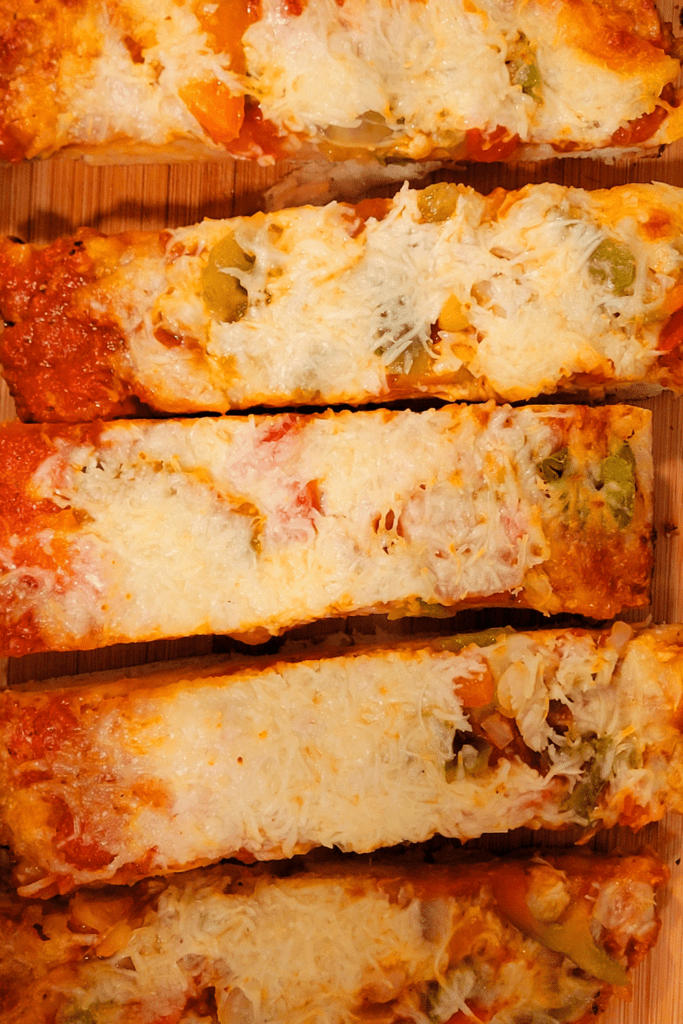
One of the best things about this recipe is how easy it is to personalize. Whether you’re a fan of classic pizza toppings like pepperoni, sausage, and mushrooms, or prefer something a little more adventurous like roasted garlic, fresh spinach, or even pineapple, the choice is yours.
The sourdough base provides a sturdy yet soft foundation that can support all your favorite toppings. The best part? You can experiment with different combinations each time you make it, making it a fun and creative meal to enjoy with family and friends.
Is Pizza Sourdough Focaccia Versatile Enough for Different Meals?
Absolutely! Pizza Sourdough Focaccia is incredibly versatile, which makes it perfect for just about any occasion. You can enjoy it as a main course for dinner, especially when paired with a light salad. It also works wonderfully as a side dish to complement soups, stews, or grilled meats.
Cut it into smaller squares and it makes for a fantastic appetizer at parties or gatherings. The best part is that it can easily be customized to fit different meal types, whether you’re having a cozy family meal or hosting a pizza night with friends. It’s a recipe that works for any time of day!
Ingredients Overview
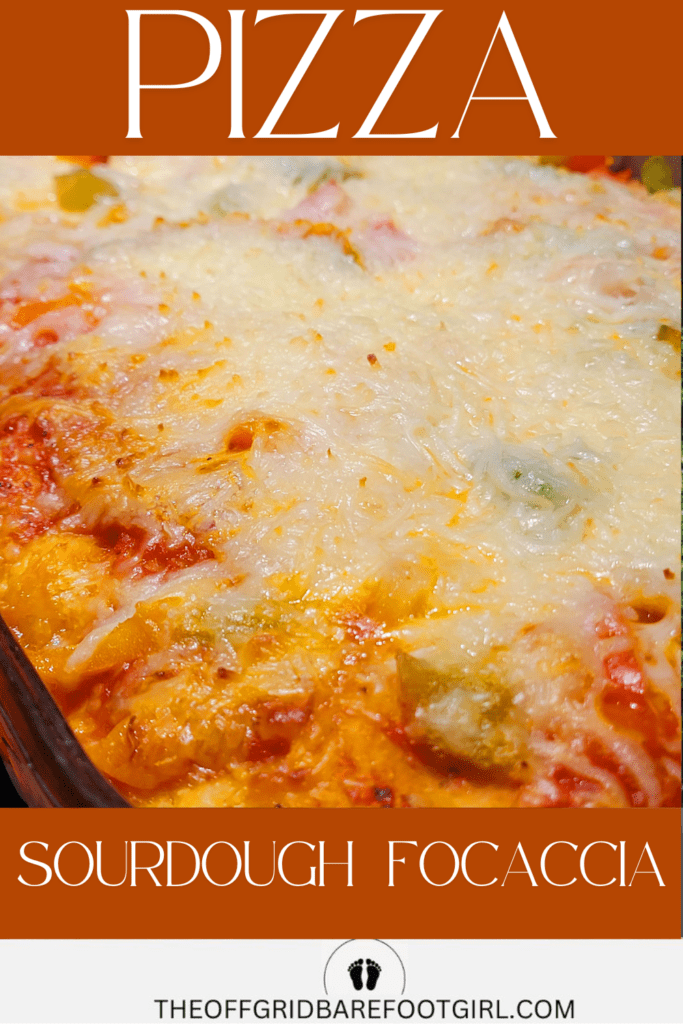
What Are the Essential Ingredients for Pizza Sourdough Focaccia?
To make a delicious Pizza Sourdough Focaccia, there are a few key ingredients you can’t skip. The sourdough starter is the most important—this is the base of the dough and is responsible for the natural fermentation that gives the focaccia its depth of flavor. The olive oil is another crucial ingredient.
It’s used both in the dough and on the top, ensuring a golden, crispy crust that’s irresistibly crunchy yet tender inside. Of course, you’ll need bread flour or all-purpose flour to give the dough structure, while a pinch of salt enhances the flavors and helps with fermentation.
How Does the Sourdough Starter Affect the Focaccia?
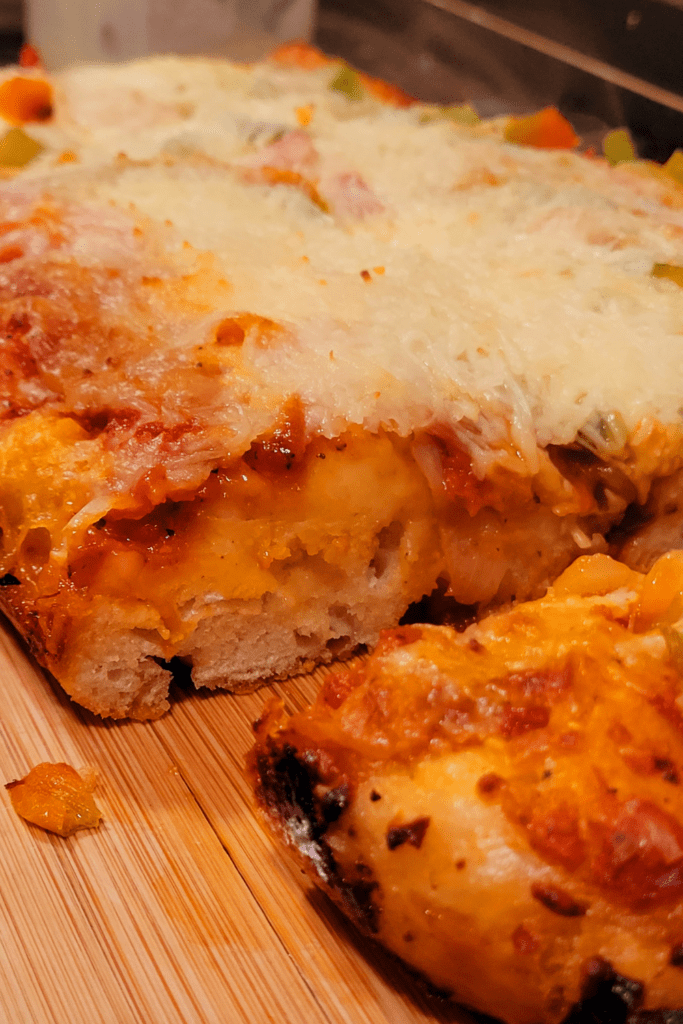
The sourdough starter is essential for that distinct flavor profile and airy texture in your focaccia. By using a sourdough starter, you’re allowing the dough to ferment naturally, which creates complex flavors that you won’t get from store-bought yeast.
The wild yeasts and bacteria in the starter work their magic over time, making the dough rise beautifully while infusing it with a slight tang. This fermentation process also aids in digestion, making the focaccia lighter on the stomach and easier to enjoy. Plus, it adds that irresistible depth of flavor that perfectly complements your pizza toppings.
Why Is Olive Oil So Important for Pizza Sourdough Focaccia?
Olive oil plays a vital role in achieving that perfect crispy crust on your focaccia. By adding it to the dough, you ensure a rich, tender crumb inside while also creating a golden, crunchy exterior. Olive oil also helps with the dimpling process, ensuring that the dough has those signature indentations that create pockets of air and texture.
A drizzle of olive oil on top before baking guarantees that irresistible crispy edge we all love. Additionally, the olive oil contributes to the overall flavor of the focaccia, giving it a subtle richness that complements the savory toppings beautifully.
What Toppings Should I Use for My Pizza Sourdough Focaccia?

The great thing about Pizza Sourdough Focaccia is that you can top it with anything you love! Start with a simple tomato sauce base, then add cheese—mozzarella, parmesan, or even gouda, depending on your preference. From there, the possibilities are endless!
Popular toppings like pepperoni, mushrooms, olives, and bell peppers work wonderfully, but you can also get creative with arugula, prosciutto, caramelized onions, or roasted garlic. Don’t forget a sprinkle of fresh basil or oregano to bring everything together. These toppings enhance the pizza flavor and give your focaccia that unmistakable pizza bite.
Are There Any Optional Ingredients for Customization?
Absolutely! While the core ingredients are essential for this pizza sourdough focaccia, there are plenty of optional additions to make it your own. If you like a little extra crunch, try seeds like sunflower or sesame on top of the dough before baking. For a touch of sweetness, you could add a drizzle of honey after baking, especially if you’re using spicy or savory toppings.
If you prefer a different flavor base, try pesto instead of tomato sauce, or swap out the mozzarella for a cheese blend of your choice. The options for customization are endless, so feel free to experiment with your favorite flavors and toppings!
Step-by-Step Instructions
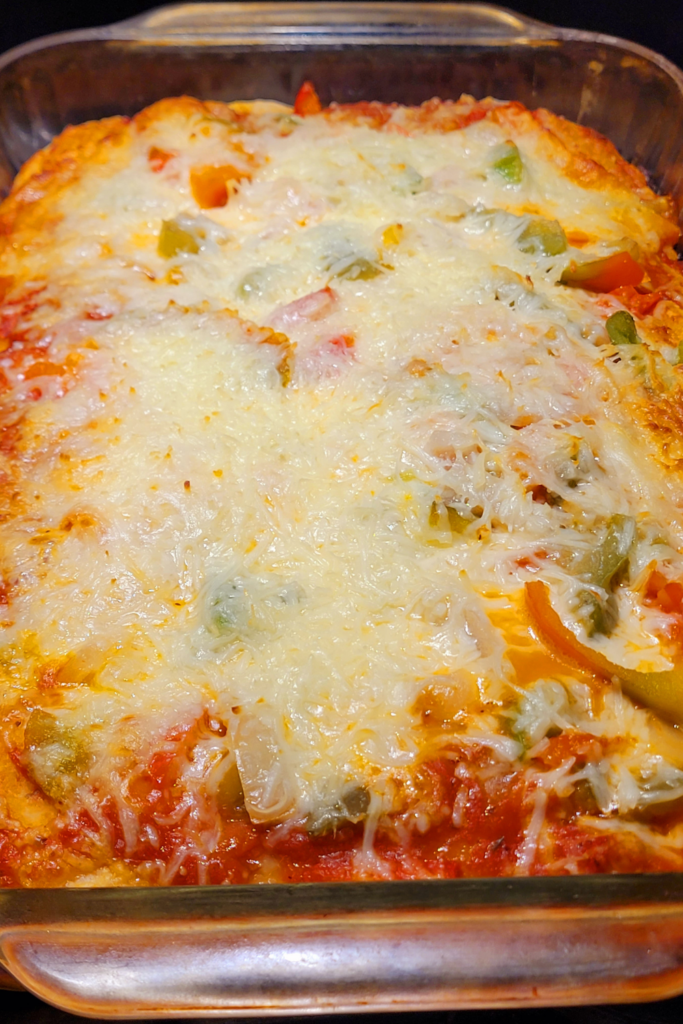
Mixing the Dough
How Do I Combine Flour, Sourdough Starter, Water, Salt, and Olive Oil to Make Focaccia Dough?
To make a delicious, well-hydrated focaccia dough, start by adding your flour and sourdough starter into a large mixing bowl. The sourdough starter is essential for fermentation, giving the dough that deep, tangy flavor we all love.
Next, pour in your water and mix everything together until a shaggy dough begins to form. At this point, add the salt to the dough for seasoning and olive oil to contribute richness and help achieve a crispy crust.
Continue mixing until all the ingredients are fully incorporated, and the dough starts to come together. The olive oil also helps to keep the dough tender and adds flavor throughout the focaccia. Don’t worry if it looks a bit rough at first—this is perfectly normal!
Why Is Resting Time Important for Focaccia Dough Texture?
Resting time is a crucial step in developing the best possible texture for your focaccia. After combining all your ingredients, resting the dough for about 30 minutes before beginning any stretch and fold process helps to hydrate the flour and relax the gluten. This makes the dough easier to work with and allows it to form a smoother texture as it rests.
The resting period also lets the yeast start to activate, which will kickstart the fermentation process. By allowing this initial rest, you’re giving the dough time to develop its structure, which is key to getting that airy, soft crumb and crispy exterior that makes focaccia so irresistible.
Stretch and Fold Process
How Does Stretching and Folding Strengthen Gluten in Focaccia?
The stretching and folding technique is key to creating a light and airy focaccia. This process helps develop the dough’s gluten network, which is crucial for giving the bread structure and a fluffy, chewy texture. When you stretch the dough, you’re gently elongating the gluten strands, and by folding it over itself, you’re allowing them to align and strengthen.
Over time, this builds the structure necessary for focaccia with a soft, open crumb and a crispy crust. The dough becomes more elastic and smooth, which is what creates those signature air pockets inside the focaccia.
How Often Should I Stretch and Fold My Focaccia Dough?
To get the best results, you should perform the stretch and fold process about 3-4 times during the dough’s initial rise. After mixing the ingredients, let the dough rest for 30 minutes, then begin the stretching and folding every 30 minutes for the first 2 hours of fermentation.
Each time, gently stretch the dough and fold it over itself to build the structure without overworking it. If you notice the dough feeling tighter, you can stop and let it rest for longer periods between folds. This technique not only strengthens the gluten but also helps the dough rise more evenly.
How Do I Know When the Dough is Ready After Stretching and Folding?
The dough is ready when it has doubled in size and feels smooth and elastic to the touch. You can perform a simple test called the “poke test”—gently press your finger into the dough, and if the indentation slowly bounces back, it’s ready for the next step. If it stays, it may need more time to rise.
When you stretch and fold the dough, you’ll also notice it becoming easier to handle and stretch, indicating the gluten is well-developed. Be patient, as giving the dough the right amount of time to rest and rise is what ensures you get that perfect, airy focaccia!
Bulk Fermentation
How Long Should I Ferment Focaccia Dough and How Do I Know It’s Ready?
Fermentation is a key step in developing the deep, tangy flavor and airy texture of focaccia. After you’ve mixed and kneaded your dough, cover it and allow it to ferment for 8 to 12 hours at room temperature. The dough will gradually rise during this time, so make sure to check it every few hours.
You’ll know the dough is ready when it has doubled in size and has a slightly jiggly texture when you gently tap the side of the bowl. This is a sign that the fermentation process has created air bubbles in the dough, which will give your focaccia the light, soft crumb we all love.
If you want to be sure it’s fully fermented, gently press your finger into the dough—if it leaves an indentation and doesn’t spring back quickly, it’s perfectly ready for the next step.
What Are the Benefits of Overnight Fermentation for Focaccia Dough?
If you’re looking for a more intense flavor in your focaccia, consider overnight fermentation. Simply mix your dough in the evening, cover it, and let it sit in the fridge overnight. This slow, cool fermentation allows the yeast to work at a gentler pace, which results in a richer, more complex flavor profile.
The longer fermentation time also allows the natural fermentation process to enhance the texture and create a more open crumb with air pockets. To make sure the dough doesn’t over-ferment, just be sure to check it before you go to bed—it should look puffy and ready for the next step in the morning.
The slow rise also makes it easier to fit this recipe into a busy schedule, as the dough can be ready for baking the next day with minimal effort.
Shaping and Proofing
How Do I Transfer Focaccia Dough to a Pan and Stretch It?
Once your dough has rested and developed its structure through stretching and folding, it’s time to transfer it to the pan. Start by greasing your pan with olive oil to prevent sticking and add extra crispiness to the crust. Gently turn the dough out onto the pan, using your hands or a bench scraper.
Instead of aggressively pulling the dough, carefully stretch it by pushing it from the center outward to fit the shape of the pan. It’s important to handle the dough gently during this step to preserve the air bubbles that give focaccia its light, airy texture. If it doesn’t completely reach the edges of the pan, don’t worry! Just cover it and let it rest for about 15 minutes before trying again.
This gentle stretching helps the dough expand evenly and will result in a beautifully risen focaccia.
Why Do I Need to Let the Dough Rise Again Before Baking?
After transferring and stretching the dough into the pan, it’s crucial to allow it to rise once more. This final rise, known as the proofing stage, gives the dough time to expand and puff up, which results in that signature soft, airy texture.
Cover the pan with a clean kitchen towel or plastic wrap, and let the dough sit at room temperature for about 1 to 2 hours, or until it has doubled in size. You’ll know it’s ready when it looks puffy and slightly jiggles when you gently shake the pan.
Don’t rush this step—letting the dough rise properly ensures your focaccia has the perfect texture, with soft, fluffy interiors and a crispy, golden-brown crust when baked.
Dimpling and Adding Toppings
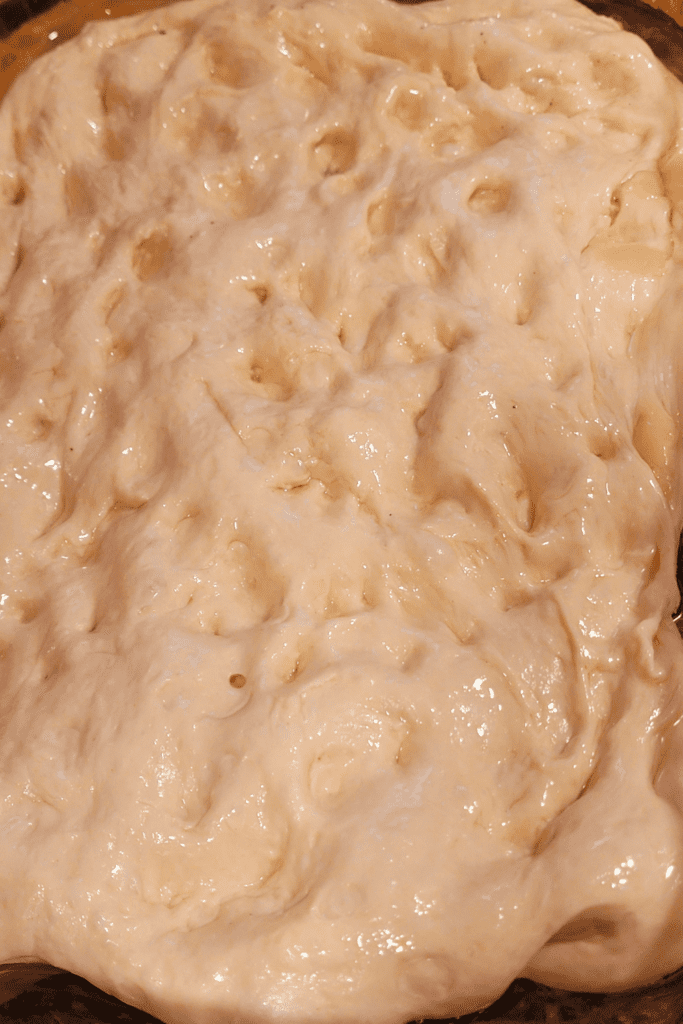
Why Is Dimpling Important for Focaccia Dough?
Dimpling your focaccia dough is more than just a decorative touch—it’s actually a key step in ensuring the dough has the perfect texture. When you press your fingers into the dough, you’re trapping air pockets inside, which creates the signature light, airy texture that focaccia is known for.
These dimples also serve to hold in moisture while baking, ensuring a soft, fluffy interior while the outside crisps up beautifully. The dimples create tiny pockets where the olive oil can pool, adding a rich flavor to every bite. This simple technique also helps the dough rise evenly during baking, ensuring you get that perfect balance of softness and crispness in each slice.
How Do I Spread Sauce, Cheese, and Toppings Evenly for the Best Bake?
When it comes to adding toppings to your focaccia, even distribution is essential for a uniform bake and flavor. After dimpling your dough, start by drizzling olive oil generously over the surface—this adds flavor and helps prevent the toppings from sticking.
If you’re adding a sauce, like pizza sauce or pesto, use a spoon or small ladle to spread it evenly, being careful not to overload the dough, as too much moisture can make the crust soggy.
Next, evenly distribute your cheese and toppings, such as mozzarella, cherry tomatoes, or olives. Be sure to space out the toppings to ensure each bite has a bit of everything. This will not only result in a beautiful bake but also ensure each slice is bursting with flavor.
By spreading everything evenly, you also help ensure that the focaccia bakes uniformly and gets that golden, crisp crust on the edges while keeping the center soft and tender.
Baking to Perfection
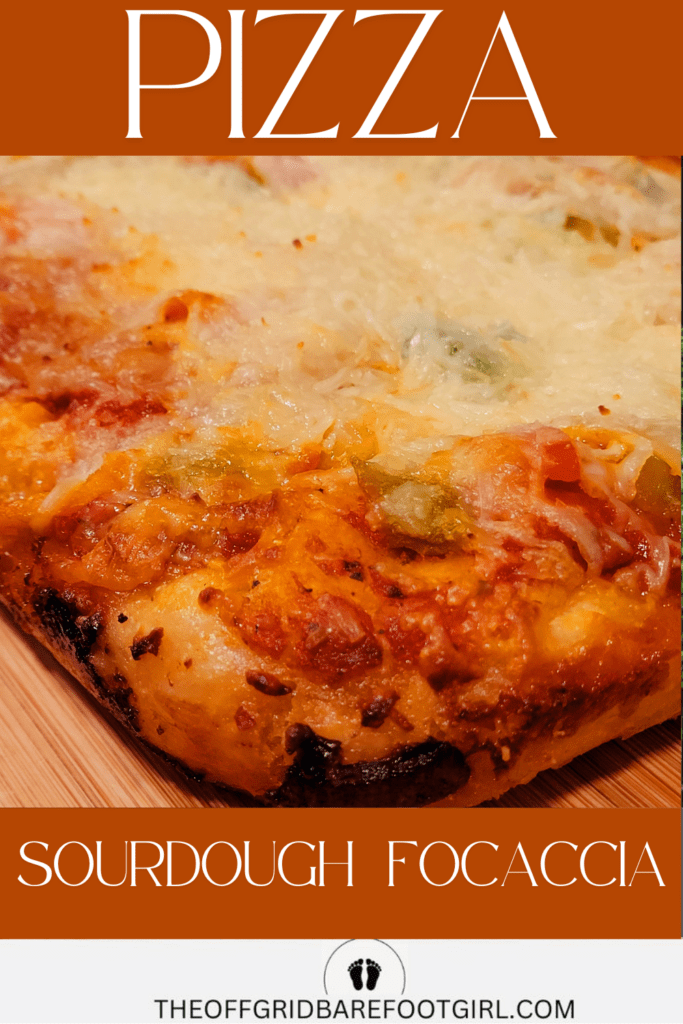
What Is the Best Baking Temperature and Time for Pizza Sourdough Focaccia?
For the best results when baking your pizza sourdough focaccia, preheat your oven to 425°F (220°C). This high heat ensures a crisp crust while keeping the interior soft and fluffy. Bake your focaccia for about 25 to 30 minutes, but keep an eye on it toward the end.
The goal is to achieve a golden, crispy crust without overbaking the dough. Every oven is a bit different, so it’s helpful to check the focaccia after about 20 minutes to gauge how it’s progressing. You’ll know it’s getting close when the edges start to turn golden brown and the top looks evenly cooked.
How Can I Tell When My Pizza Sourdough Focaccia Is Done Baking?
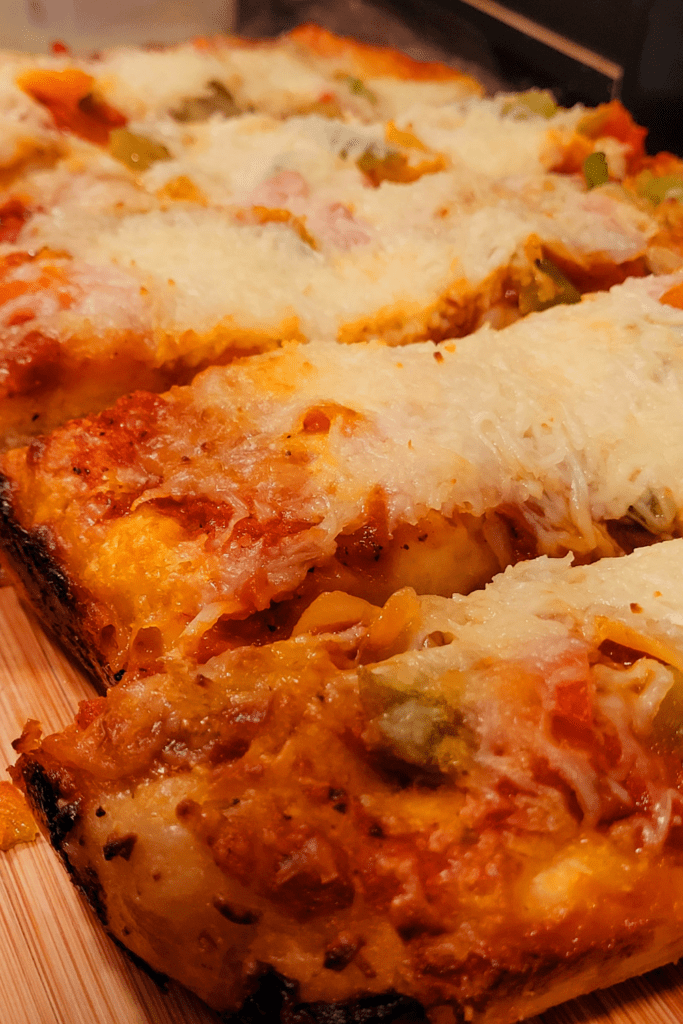
To check if your focaccia is fully baked, look for a golden-brown crust around the edges, which indicates a crispy exterior. Another key visual cue is the cheese—if you’ve added cheese, it should be bubbling and slightly browned. This means the toppings are perfectly melted and the dough has cooked through.
You can also gently tap the bottom of the focaccia with your fingers or a spoon; it should sound hollow, indicating it’s done. If the crust is too pale, you can extend the baking time by a few minutes, but make sure to check regularly to avoid burning the crust. This combination of golden crust and bubbling cheese ensures that your focaccia will be perfectly baked every time.
Serving and Storage Tips
What Are the Best Ways to Serve Pizza Sourdough Focaccia?
Pizza sourdough focaccia is incredibly versatile and can be served in several delicious ways. For a light meal or appetizer, I love pairing it with a fresh salad. The contrast between the crispy, savory focaccia and the refreshing crunch of a salad is perfect. It also makes an excellent companion to a warm bowl of soup—especially a tomato or vegetable soup, where the focaccia can be used for dipping.
For a more indulgent experience, try serving it with dipping sauces like marinara, garlic butter, or even a balsamic glaze. Whether you’re serving it as a side dish or as the main event, this focaccia will impress everyone at your table.
How Should I Store Leftover Pizza Sourdough Focaccia?
If you find yourself with leftovers, storing pizza sourdough focaccia properly will ensure it stays fresh for as long as possible. For short-term storage, simply wrap the focaccia in plastic wrap or foil and store it at room temperature for up to 2 days. If you need to keep it for longer, place it in the refrigerator for up to 5 days. If you want to keep it even longer, you can freeze the focaccia.
Wrap it tightly in plastic wrap and then in aluminum foil, or place it in a freezer-safe bag. Frozen focaccia can last for up to 3 months. To reheat, I recommend placing it in a preheated oven at 350°F (175°C) for about 10 minutes to restore its crispy texture, giving you the perfect bite every time.
How Can I Reheat Pizza Sourdough Focaccia for the Best Texture?
To enjoy pizza sourdough focaccia at its best after storing, you’ll want to reheat it so that it maintains that perfect combination of a crispy crust and soft, airy interior. For the best results, place the focaccia in a preheated oven at 350°F (175°C) for about 10 minutes. This method helps to crisp up the crust while warming the toppings and interior.
If you’re reheating a slice, you can wrap it in foil to prevent it from drying out, or if you prefer a more crispy bite, place it directly on the oven rack. Alternatively, if you’re in a hurry, you can reheat it in a skillet over medium heat for 2-3 minutes per side—this will give it a nice crispy bottom while keeping the inside warm.
Recipe Variations and Customization Ideas
What Toppings Can I Experiment With on Pizza Sourdough Focaccia?
One of the best things about pizza sourdough focaccia is how customizable it is! I encourage you to get creative with the toppings. For a veggie-packed focaccia, try adding roasted vegetables like zucchini, bell peppers, or mushrooms. Their caramelized flavors pair wonderfully with the sourdough base.
If you’re craving a fresh, vibrant twist, sprinkle some fresh herbs like basil, oregano, or thyme over the top just before baking. For those who enjoy a little heat, consider adding a few spicy elements like red pepper flakes, jalapeños, or even a drizzle of hot sauce after baking. With endless topping possibilities, you can create a new favorite version every time.
Can I Make Pizza Sourdough Focaccia Dairy-Free or Gluten-Free?
If you have dietary restrictions or preferences, you’ll be happy to know that pizza sourdough focaccia can be modified to suit your needs. For a dairy-free version, simply substitute the cheese with a dairy-free alternative or skip it altogether, focusing on the other toppings for flavor.
If you want to go all-in on the flavors, consider using nutritional yeast as a cheesy, vegan-friendly topping. For those following a gluten-free diet, you can swap the regular flour for a gluten-free flour blend, though the texture may differ slightly.
Keep in mind that gluten-free doughs sometimes require additional hydration, so adjust the water content as needed to get the right dough consistency. With these adjustments, everyone can enjoy a slice of this delicious focaccia!
Conclusion
Why Should I Try the Pizza Sourdough Focaccia Recipe?
I highly encourage you to try making this pizza sourdough focaccia yourself! It’s a fun and rewarding recipe that brings together the tang of sourdough with the comforting flavors of pizza, creating a delightful dish that’s perfect for any occasion.
Whether you’re a seasoned baker or just starting your sourdough journey, this recipe is a great way to experiment and improve your skills. The best part? The flexibility! You can customize it with your favorite toppings and tweak the recipe to suit your tastes. Don’t forget to share your results – I’d love to hear how it turns out for you and what creative toppings you tried!
If you’ve made the pizza sourdough focaccia, I invite you to share your results in the comments section below! I love hearing from my readers and seeing how you’ve personalized the recipe. If you have any questions or run into any issues while making it, feel free to ask – I’m happy to offer tips and guidance.
Baking can be an adventure, and it’s always helpful to learn from each other’s experiences. While you’re here, be sure to check out some of my other sourdough recipes – there’s a lot more to explore in the world of sourdough baking, from bread to rolls and even sweet treats!
Resources: Here are some helpful resources for further information.
- Rosemary Garlic Focaccia Bread – By Ally’s Sweet & Savory Eats
- The Easiest Herbed Focaccia Bread – By Oh Sweet Basil
- Cheesy Garlic Sourdough Focaccia – By Amy Bakes Bread
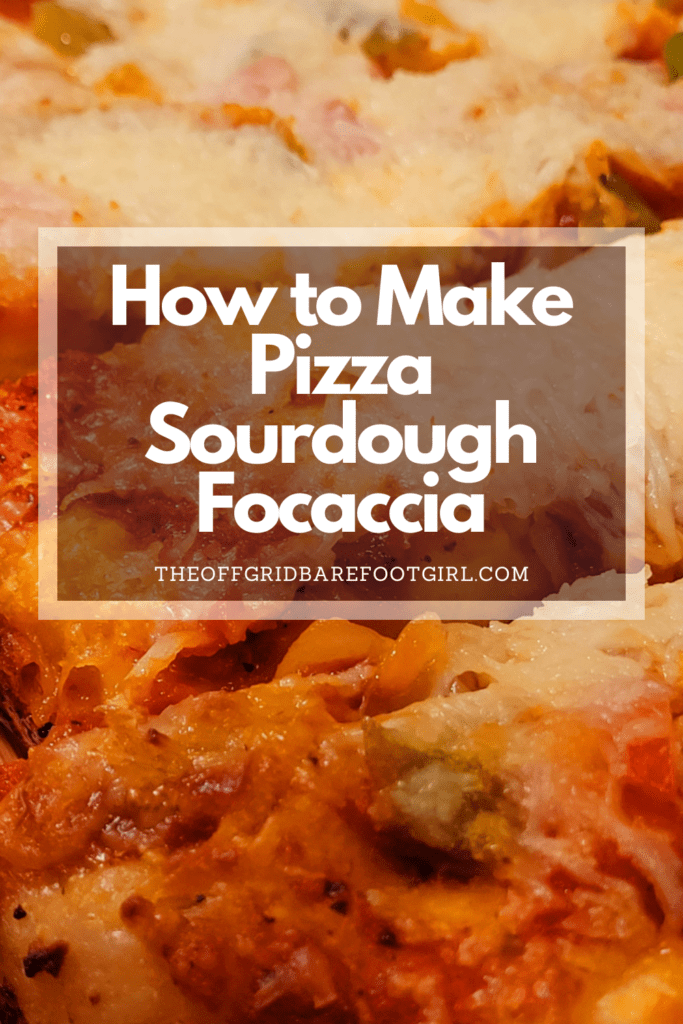
Frequently Asked Questions
1. Can I use a store-bought sourdough starter for this recipe?
Yes, you can! If you don’t have a homemade sourdough starter, a store-bought one works perfectly fine. Just make sure it’s active and bubbly for the best results.
2. How long should I ferment the dough?
For the best flavor and texture, ferment the dough for about 8-12 hours at room temperature. If you want to develop a deeper flavor, you can let it ferment overnight in the fridge.
3. Can I customize the toppings on the focaccia?
Absolutely! This pizza sourdough focaccia is super versatile. You can add your favorite pizza toppings, such as roasted vegetables, pepperoni, olives, or fresh herbs. Get creative!
4. How should I store leftovers and reheat them?
Store any leftovers in an airtight container at room temperature for up to 2 days. For longer storage, you can freeze it. To reheat, simply warm it in the oven at 350°F (175°C) for 10-15 minutes to bring back its crispiness.
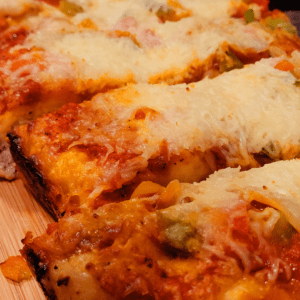
Pizza Sourdough Focaccia
Equipment
- 1 mixing bowl
- 1 9×13 inch baking pan.
Ingredients
For the Dough
- 1 ½ cups (375g) warm water.
- ½ cup (100g) active sourdough starter.
- 4 cups (500g) bread flour or all-purpose flour.
- 2 tsp (10g) salt.
- 2 tbsp honey.
- 2 tbsp (25g) olive oil.
For the Toppings
- ½ cup pizza sauce.
- 1 ½ cups shredded mozzarella cheese.
- ½ cup of any and each toppings you want.
Instructions
For the Dough
- Prepare the Dough: In a large bowl, combine the water, sourdough starter, flour, salt, honey, and olive oil. Mix until the dough forms a shaggy consistency. Let it rest for 30 minutes.
- Stretch and Fold: Perform 3-4 sets of stretch and folds, resting for 30 minutes between each set. This helps build gluten, making the dough light and airy.
- Bulk Fermentation: Cover the dough and let it ferment at room temperature for 8-12 hours (overnight for best flavor). The dough should double in size.
- Shape the Dough: Grease a 9×13-inch baking pan with olive oil. Gently transfer the dough to the pan, stretching it to fit the edges. Let it rest for another 1-2 hours to rise further.
- Preheat Oven: Preheat your oven to 425°F (220°C).
- Add Toppings: Once the dough has risen, dimple the top with your fingers. Spread the pizza sauce evenly across the dough, sprinkle with shredded mozzarella, and add your favorite toppings (like pepperoni or fresh herbs).
- Bake the Pizza Focaccia: Bake for 25-30 minutes, until the crust is golden brown and the cheese is bubbling and melted.
- Cool and Serve: Let the focaccia cool slightly before cutting into squares. Serve with extra dipping sauce if desired.
- Enjoy this delicious, crispy, and airy pizza sourdough focaccia as a meal, snack, or party dish!
Summary
I hope I have inspired you to bake your very own bread loaves to enjoy and share with your friends and family.
If you were encouraged by this post, I invite you to check out my FREE Printables Page for fun free printables, planners, and charts.
ENTER MY FREE Printables Page HERE
Here are some more of my bread-making inspiration posts to check out!
How to Make Carrot Cake Sourdough Focaccia
Easy and Delicious Hershey’s Kisses Sourdough Bread
How to Make Amish Whoopie Pies!
Lazy Cinnamon Rolls: How to Make Easy Cinnamon Rolls the Lazy Way!
Lembas Bread: How to Make Elven Lembas Bread: A Taste of Rivendell
Gnome Bread: How to Make a Sourdough Gnome Bread
The Best Hoagie Buns Recipe Made From Scratch!
Pumpkin: How to Make Chocolate Chip Pumpkin Bread
Sweet Potato Bread: How to Make Sweet Potato Bread
Chocolate Chip Cookies: How to Make Chocolate Chip Cookie Bread
Carrot Cake Quick Bread: How to Make Carrot Cake Quick Bread
How to Make Strawberries and Cream Sourdough Bread
How to Make S’mores Sourdough Bread
July 4th Bread: How to Make a Firecracker Marble Bread Braid
Artisan Bread: How to Make Artisan Bread
Challah Bread: How to Make a 6 Braided Challah Bread
Sweet Bread: How to Make Sweet Bread
Blessings,
The Off Grid Barefoot Girl

